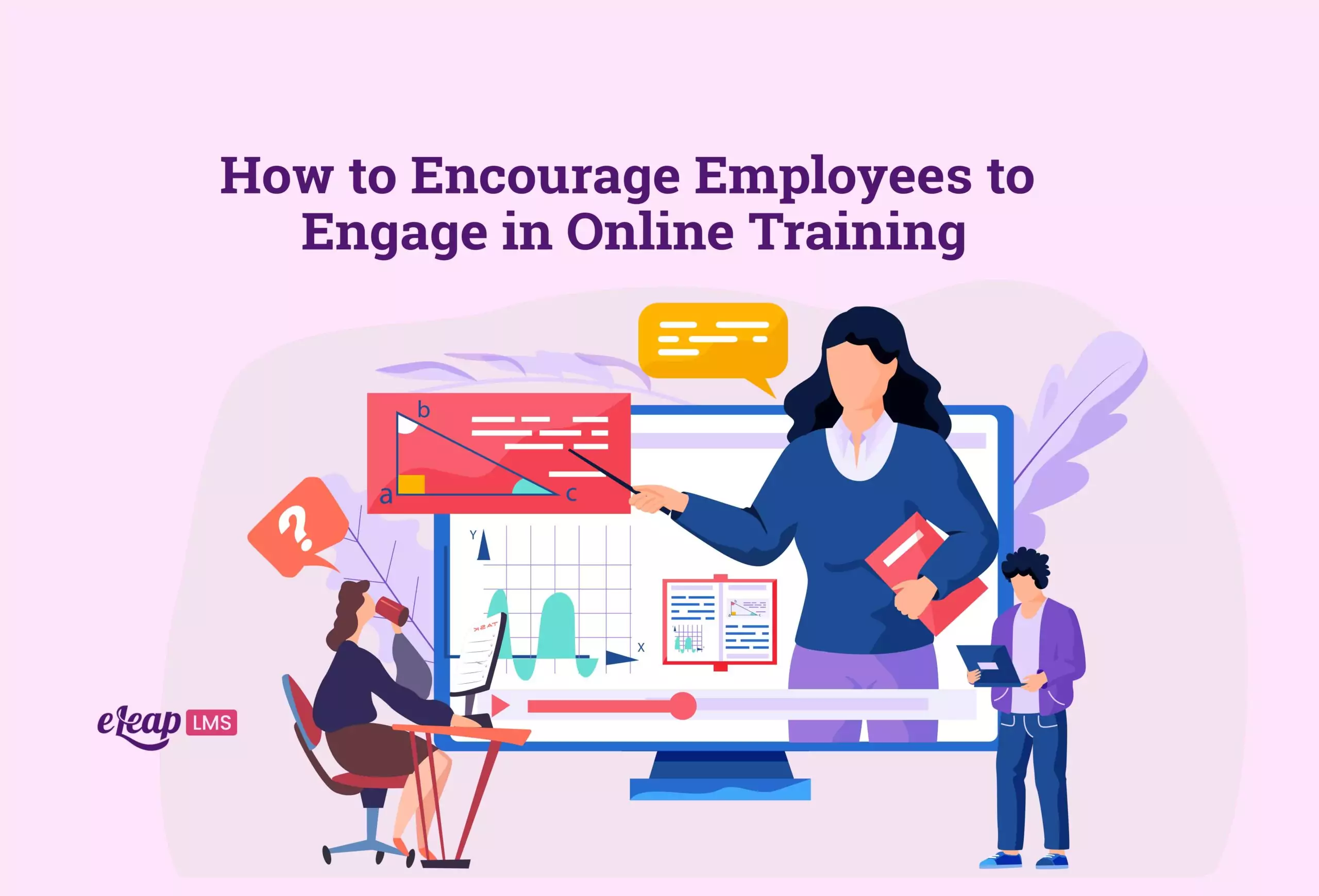How to Encourage Employees to Engage in Online Training

In today’s fast-paced business environment, ongoing employee training and development is crucial for a company’s success. The shift to remote work due to the pandemic has made it even more important for organizations to find new ways to engage their employees in online training. But, let’s face it, only some people are excited about taking online courses. The good news is there are ways to make online training more engaging and motivating for your employees.
This blog will explore practical tips and best practices for encouraging your employees to participate in online training and continue their professional growth. Whether you’re a manager, HR professional, or simply someone who wants to improve their team’s training experience, this blog is for you. So, let’s dive in and discover how to get the most out of your company’s online training program.
How to Encourage Employees to Take Online Training
The following guidelines should help create and maintain your employees’ enthusiasm for online training:
Customize The Online Training Program
A significant way of motivating employees to take up online training is incorporating elements they can relate to into the program. It is not beneficial if the training is just another rigid-structured program forced down the throats of employees by their superiors. The employees in an organization will most likely have different training needs; therefore, you should meet them individually at the point of these needs to nurture top talents. This can only be possible if the online training program accommodates the personal interests and needs of every employee.
Study the personalities of your employees before you deploy any online training program. Customizing the online training program boosts the employees’ motivation and gets them hooked to the training. It will help your employees to bridge their performance deficiencies and achieve professional goals.
Encourage Employees To Create Their Milestones
Enabling employees to set their achievement milestones offers two significant benefits. First, it allows them to set their schedule, development plan, and pace at which they’ll complete the training instead of struggling to keep up with their counterparts. Secondly, the employees can focus on the goals and objectives that they can mostly resonate with. For instance, those that align with their job duties or areas in which they need improvement. This way, they can monitor their progress through the entire process and discover how long they’ll still need to go to catch up. Thus, if at any point in time, they are distracted from the finish line or get tempted to give up, their milestones are a valuable tool to boost their motivation. The eLeaP learning system can help in this case.
Provide Continual Support

Your employees need consistent support to enhance comprehension and reinforce performance behavior. Guided employees are less likely to disengage, get distracted, or give up during training. A helping hand to provide appropriate online training resources goes a long way. Humans love to feel prioritized; they’ll feel special upon realizing that their organization is willing to go above and beyond to provide them with continual support without question. They need to know that the online training course is as beneficial to their career advancement as it is to organizational development. This encourages them to continue to hone their skills and become productive in the workplace.
Collaborate The Online Training
Online training is usually more relatable and captivating when carried out as a group instead of individually. Group- collaborated assignments and projects foster online collaborations. This catches the interest of corporate learners to take up online training. They will be able to hold conversations regarding different techniques to solve problems, which is more fun than battling a problem individually. In this instance, employees get to share and exchange opinions and ideas. This boosts their skills and knowledge scope. In addition, group-collaborated activities expose them to interacting with their counterparts and tapping from their experiences.
Utilize Social Media Resources
People have become accustomed to social media. Organizations can use this medium to make online training more enjoyable. Social media provides employees with the ground to communicate with several corporate learners regarding training topics.
Introduce Gamification
You can set up a reward system where your employees can earn badges or points after the successful completion of every online training course. This helps to keep them on their feet. Knowing there’s a reward for their effort urges them to do more than they ordinarily would have done if no reward system was attached. Including incentives for an online training course boosts employees morale, and keeps them dedicated to such courses.
Challenges Employees Encounter During Online Training
Here are some of the most common challenges employees face while taking online training programs:
Time Management
In today’s world, employees usually do not have more than twenty minutes of spare time in the average work week to channel toward development and learning. In this situation, microlearning is a perfect design strategy for online training programs to prevent your employees from getting overwhelmed with the entire process. Microlearning breaks down contents into smaller sections of about five to ten minutes. Each section addresses a single training objective, making it easy for corporate learners to assimilate quickly.
Accessibility
Employees should be able to access the training courses whenever they can. It’s no use if the training is only incorporated into specific PCs within the organization. Some individuals do well with assimilation at night before bedtime instead of morning. Thus, if they can’t access the training through their mobile devices, how will they study at their convenience?
Internet Access
Organizations that incorporate online training for their employees must provide internet access. An online training program is only possible if employees have adequate internet access.
Training can cause mumbling and grumbling amongst the employees in a company. Employees sometimes have a hard time seeing how training and development provide opportunities for them to advance their skills and knowledge, as well as excel in their careers. Use these three tips to help encourage employees to engage in online training to create a win-win situation for the employees and for the business.

Go Mobile
Offering online training automatically creates a flexible training option for employees. It allows them to remain in the office or at home to attend and complete training, rather than having to travel to seminars and training courses in far off places. Another way to encourage employees to engage in online training is to offer mobile training options. Instead of forcing them to always sit in front of a computer screen, offer SMS and other mobile options for employees to receive tips, tricks and activities to complete their training.
Offer Incentives
Consider offering some kind of bonus or incentive for those employees that complete the training courses. Each incentive should be tied to each milestone the employee reaches. Offer a bonus for completion of individual training modules as well as for completing the entire training course. Bonuses or incentives can vary according to the importance and length of the training. A bonus can be as simple as one paid day off from work to gift cards and free merchandise. How to incentivize team members to complete their training.
Find the Expert
Nothing makes employees want to attend a training session more than when there is a famous person or guru offering the training. When you are offering training sessions for employees, try to find the expert for that niche or topic. It can be an award-winning best-selling author. It can be a celebrity talk show host. It can be an industry celebrity. The more exciting the trainer is, the more excited the employees tend to be about attending the training and the more likely they are to attend it with enthusiasm and zest.
Illustrate the Benefits
Avoid focusing on the features of the online training. Instead, home in on how the training brings benefits to the employee—personally. Instead of saying that the training makes the employee more productive, tell the employees that the training provides them with techniques to do their job faster so that they finish their work more quickly than using old techniques.
Training is not always an exciting adventure that employees cannot wait to embark upon. At times, it takes some work on the part of the company executives and management to encourage employees to attend online training sessions. When you use these techniques as encouragement, it creates a win-win situation where the employees want to attend the training and the company walks away with employees that are more efficient and effective than they were prior to the training.
Final Thoughts
Encouraging employees to engage in online training is crucial for the growth and success of any organization. By providing employees with the right tools, resources, and support, you can create a positive and productive learning environment. This will foster growth, innovation, and collaboration in the organization. From offering incentives and recognition programs to creating a supportive culture and engaging learning experiences, there are many ways to encourage employees to embrace online training and reach their full potential. So, take the time to invest in your employees, and watch as your organization thrives and grows with the power of continuous learning and development.
- 7 Critical Questions about e-Learning: What Executives and HR Professionals Need to Know
- Do you want to learn How to Jumpstart an E-Learning Program in Eight (8) Easy Steps?
- Training Software Cuts Down on Employee Training Costs
- 5 Questions to Ask when Launching an Online Training Program
- How to Have a Great Company Culture for Remote Workers